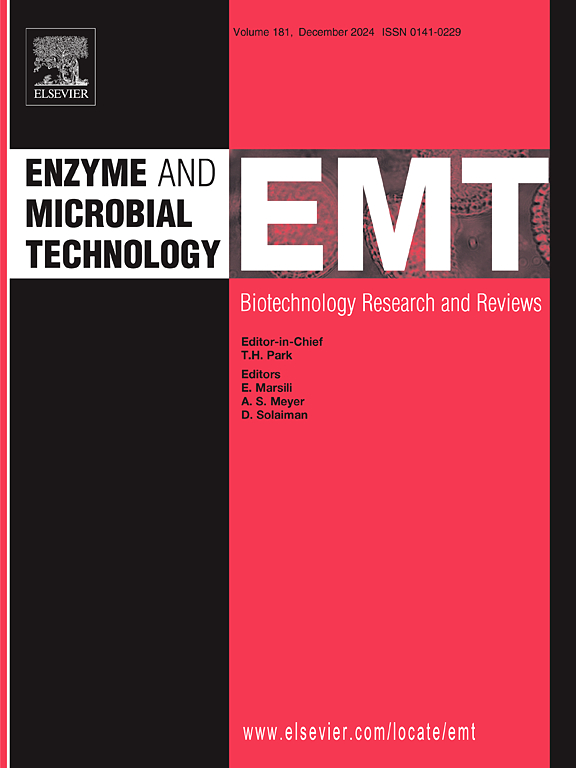α-氨基酸酯酰基转移酶EAET的分子修饰和工艺优化促进丙氨酰-谷氨酰胺二肽的合成。
IF 3.7
3区 生物学
Q2 BIOTECHNOLOGY & APPLIED MICROBIOLOGY
引用次数: 0
摘要
本研究利用分子工程技术开发了高性能α-酯酰基转移酶(EAET),在酶促合成丙氨酰-谷氨酰胺(Ala-Gln)方面取得了重大进展。我们成功地从矮芽孢杆菌中克隆了EAET,该菌株具有低序列同源性(本文章由计算机程序翻译,如有差异,请以英文原文为准。
Enhanced synthesis of alanyl-glutamine dipeptide via molecular modification and process optimization of α-amino acid ester acyltransferase EAET
This study presents a significant advancement in the enzymatic synthesis of alanyl-glutamine (Ala-Gln) through the development of a high-performance α-ester acyltransferase (EAET) using molecular engineering. We successfully cloned EAET from Bacillus pumilus, which exhibits low sequence identity (<30 %) compared to other reported acyltransferases (AETs). Using AlphaFold3, we constructed a highly reliable structural model of EAET, validated by metrics such as pLDDT, ipTM, and PAE. Through semi-rational design, we introduced the F330Y mutation, which enhanced enzymatic activity by 1.5-fold and extended the half-life at 30°C by 1.3-fold. Molecular dynamics simulations revealed increased flexibility around residue 330 and additional hydrogen bonds in the F330Y mutant, both of which contribute to its improved catalytic efficiency and thermostability. Response surface methodology was employed to optimize enzyme production conditions, resulting in a maximum enzyme activity of 218.20 U/mL[91.3 U/(mL·OD600)]. Systematic optimization of catalytic parameters, including pH, temperature, substrate ratio, concentration, enzyme dosage, and reaction time, enabled an 82.59 % conversion yield at 300 mM substrate concentration. These results not only surpass previous benchmarks but also demonstrate the industrial potential of engineered EAET variants for Ala-Gln synthesis. This study highlights the successful integration of computational tools with molecular engineering to enhance enzyme performance, offering a greener and more sustainable approach for Ala-Gln production.
求助全文
通过发布文献求助,成功后即可免费获取论文全文。
去求助
来源期刊

Enzyme and Microbial Technology
生物-生物工程与应用微生物
CiteScore
7.60
自引率
5.90%
发文量
142
审稿时长
38 days
期刊介绍:
Enzyme and Microbial Technology is an international, peer-reviewed journal publishing original research and reviews, of biotechnological significance and novelty, on basic and applied aspects of the science and technology of processes involving the use of enzymes, micro-organisms, animal cells and plant cells.
We especially encourage submissions on:
Biocatalysis and the use of Directed Evolution in Synthetic Biology and Biotechnology
Biotechnological Production of New Bioactive Molecules, Biomaterials, Biopharmaceuticals, and Biofuels
New Imaging Techniques and Biosensors, especially as applicable to Healthcare and Systems Biology
New Biotechnological Approaches in Genomics, Proteomics and Metabolomics
Metabolic Engineering, Biomolecular Engineering and Nanobiotechnology
Manuscripts which report isolation, purification, immobilization or utilization of organisms or enzymes which are already well-described in the literature are not suitable for publication in EMT, unless their primary purpose is to report significant new findings or approaches which are of broad biotechnological importance. Similarly, manuscripts which report optimization studies on well-established processes are inappropriate. EMT does not accept papers dealing with mathematical modeling unless they report significant, new experimental data.
 求助内容:
求助内容: 应助结果提醒方式:
应助结果提醒方式:


